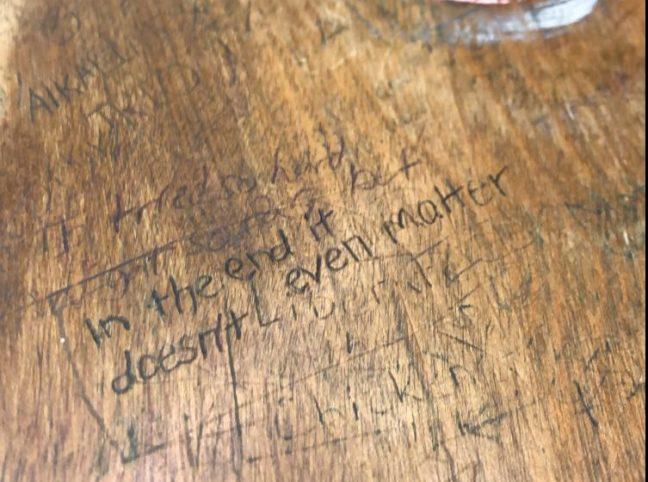Many people probably don’t pay much attention to the crude illustrations and carvings scattered throughout most lecture halls — eventually, they become an almost unnoticed component of the classroom environment. But I find desk art fascinating in the sense that it’s perhaps the purest reflection of the University of Wisconsin student body.
For example, take the Brogden Psychology Building. Many of the desks in Brogden’s main lecture halls have not been replaced in a very long time, as evidenced by their wood construction. For the aspiring lecture-time graffiti artist, wood is the perfect canvas. These desks are layered in doodles and phrases, drawn, carved or otherwise.
Much of this graffiti has little meaning beyond the immature sentiments which one would anticipate. Lots of phallic references — and illustrations — inscribed next to proclamations of love both for humans and Bucky Badger, and an awful lot of profanity aimed at the University of Michigan.
But after staring at these drawings for a while, it’s possible to gain a unique glimpse into the everyday struggles and triumphs of a UW student.
On the day of my first chemistry exam, I walked into my psychology lecture feeling exhausted, underprepared and indescribably nervous. As I reached down toward the chair in front of me to unfold my desk, I noticed a somewhat large carving which read “Chem sucks.” Since that time, I’ve noticed Chemistry 103 is a common target for desk doodlers. Phrases such as “chem kills” and “don’t take chem” litter the desks of lecture halls across campus.
In this instance, Brodgen’s graffiti paints a portrait of a student body pushing its way through a common academic barrier, venting its endless frustration in the form of crass yet honest notes.
In analyzing desk doodles, one can also gain a glimpse into Madison’s political views. Never have I seen President Trump so heavily berated than on a backrest or bathroom wall. Depending on the age of the lecture hall you’re sitting in, the same might hold for George W. Bush — and many other former Republican politicians, for that matter. After searching for long enough, you might come across criticism of Ronald Reagan.
Graffiti is a subject which, surprisingly, has been studied extensively. The earliest instance of bathroom graffiti, the scatological cousin of desk graffiti, can be traced back to the early 18th century, and even has its own academic terminology, “latrinalia.” Overall, research seems to indicate that graffiti artists engage in their nefarious activities primarily due to boredom or a need to be heard.
Arthur Vasquez, a senior lecturer in Criminology and Criminal Justice at The University of Texas at Arlington, emphasized the latter.
“We all want to be heard or be recognized for something we did, and taggers are no different,” Vasquez said.
It may be difficult to look past the crude and juvenile nature of desk graffiti, but when one begins to consider the underlying emotions and motivations that graffiti represents, it becomes apparent that desk graffiti is more than just a smattering of senseless jokes. It’s more or less a diary written by UW’s student body. It’s reflective of our academic challenges, political views and our need, as young adults, to have our voices heard.
John Grindal (grindal@wisc.edu) is a freshman studying computer science and neurobiology.


